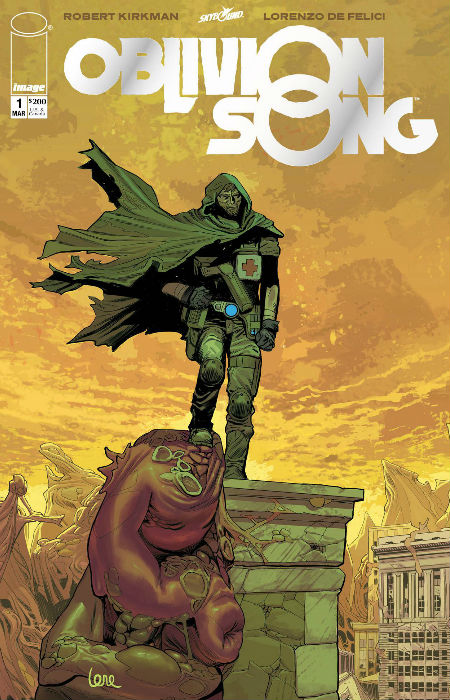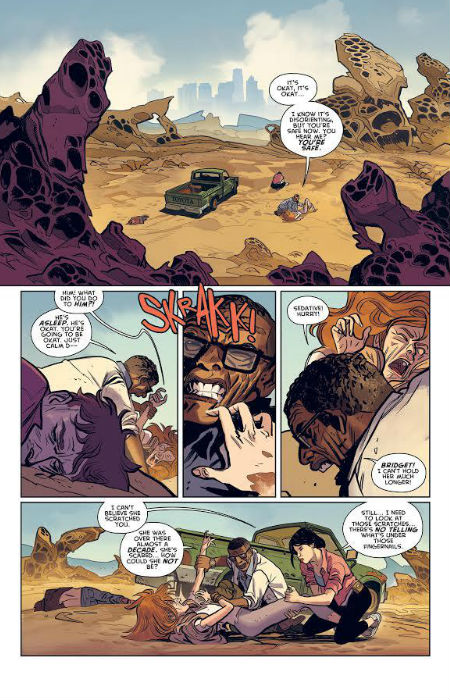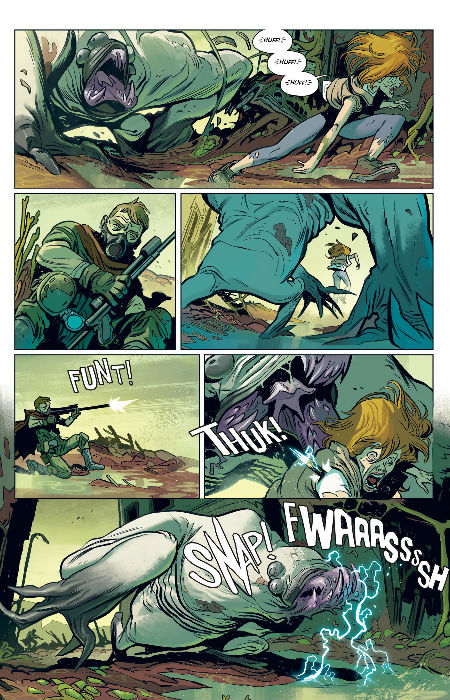
The apocalypse is big business these days.
For some reason, and it may have something to do with the fact that ever since the optimistic blush of post-World War Two idealism wore off in the early 1970s that we’ve become more and more convinced the world is going to hell in a handbasket, everyone is obsessed with a thousand different ways the world might end …
… and, more intriguingly for a storyteller, what happens after that cataclysmic event.
Robert Kirkman, through his The Walking Dead comics and TV series, and the spinoff series Fear the Walking Dead, has been one of the people at the forefront of this fascination with a bleakly dark and deadly future, asking time and again what it would mean for humanity to be faced with this most horrific of existential crises?
Would we rise, nobly and selflessly to the challenge, or cave in on ourselves and employ our best (read: worst) Darwinian tendencies for a race to the self-preserving bottom, alive but with little that made us stand above the evolutionary crowd intact?
It’s an intriguing, multi-layered question and one he explores once again, with talented artist Lorenzo De Felici, in his new comic book series Oblivion Song which explores what happens when 300,000 of Phildelphia’s citizens are absorbed, with no warning into an alternate dimensional hellscape known, you might have guessed, as Oblivion.
Populated by beastial monsters and the stuff of nightmares on acid, the Oblivion kills many of its unwilling captors as the government does it best to save as many of its people from their dimensional prison as they can.
But as so often happens even in the more mundane and terrestrial of disasters – and I use the word “mundane” only as a contrast to the freakish otherworldliness of Oblivion – people lose interest, the news cycle powers down and its left to survivors and their families to do what they can do to save those they love and have lost.

Nathan Cole, whose estranged brother Edward may still be trapped in the mindlessly terrifying expanse of Oblivion – the land it consumed in Philadelphia before disappearing is a desert wasteland, with the only way to reach the alternate dimension through darts that allow movement across the barrier between the worlds (Nathan has more freedom of movement than that) – is pretty much the last man left standing, working with Bridget and her Oblivion-survivor husband Duncan (who suffers from PTSD and in unaware his wife forged a new life with a new man during the many years her husband was missing and presumed dead).
With a dogged determination borne of the need to do the right thing and no doubt find his brother – he is accused repeatedly of doing it for wholly selfish reasons but you wouldn’t keep exposing yourself to such nightmarish danger and possible death – there are a number of close scrapes with mortality in just the first few issues – Nathan keeps pushing back into Oblivion to rescue people like Thomas and Patricia Crenshaw, a married couple who, like most rescue survivors, can’t adjust to the fact that they are safe from the monsters.
It’s a common thread in the series so far – what happens after your rescued? Is the happily-ever-after really all that happy or is it an agonisingly awful safety and nothing more? Can you ever leave that kind of trauma behind?
Given the fact that Oblivion Song is bouncing between Oblivion itself, where it turns out some survivors, organised and led by the mysterious Ed who may or may be Nathan’s missing brother, have actually, and weirdly, made themselves a new life, present-day scarred Philadelphia where a massive memorial museum to this hopefully one-off apocalyptic event dominates the city, physically and psychically, Nathan’s relationship with Heather who works in city government, and the experiences of rescued survivors, it somehow manages to tell an engrossingly complex story.
It’s not perfectly executed, of course, but given the profusion of imaginatively-articulated moving parts, that’s to be expected, with an interesting premise, some nicely-brought to life characters and some incisive perceptiveness about government and society and they can be out of step with basic humanity giving the series, thus far at least, a robust well-roundedness.
What is fascinating is how something this cataclysmic, this devastating could be so easily ignored, after the initial panic and rush to rescue survivors has subsided? Surely the public, the families of the 300,000 not yet accounted for would be baying at the doors of government, beseeching the media, begging people like Nathan to do more, much more?

Two scenes explain why this isn’t happening, at least not in the way you expect.
Nathan, fronts to a meeting at city hall organised by Heather where he must keep his cool – like most outliers, he is passionate to the point of rudeness and subordination, unable to conceive how anything other than going in and saving people matters; fair enough, in a perfect world, that would and should be the sole consideration – in order to get the funds he need to expand his team back to the size it once was before government decided the mission was fulfilled.
The fact that people are out there, and that Nathan keeps finding and saving them suggests that’s not the case at all, but it appears the government, worried that continual movement through the dimensional barrier might be weakening it, something which could lead to a repeat of events a decade earlier, and other considerations not articulated, feels it’s simply not feasible to reopen the program to its full strength and leaves Nathan as an effective one-man band.
Later on, he goes to see his old tea member Marco who is uneasy about Nathan’s requests to come back with him into Oblivion – the series titles comes from Duncan’s relocation of the “music” you would hear in the rare, quiet moments you weren’t running from monsters when all you could hear was “the breeze, the creatures in the distance, insects” sounding like nothing in our dimension – and eventually rejects his request, deferring his wife Lucia’s fears about him going back in and his own understandable terror.
It’s this cumulative, ever-present horror, this sense that Oblivion is but a permeable barrier away and that everything could go to hell again, that I think powers the reluctance of government and the populace – how is Philly not a ghost town? I’d have packed up and left but then like most people, could I afford to? – and the crowds that surge through the museum, afraid of the reminders it provides but unable to look away since the reality of it all is but a transitional event away?
In Kirkman’s other creative endeavours, you can’t escape the apocalypse since it’s everywhere; but in Oblivion Song, rich with humanity, portent, lingering hope and grief and loss, people feel like they can ignore it, well enough to get on with their lives in something approaching normalcy.
Of course, that’s a fallacy, which Nathan and survivors like the Crewshaws and Duncan prove each and every day but among the many insights Oblivion Song provides through its immersive narrative and stunningly evocative art – De Felici’s artwork is a thing of beauty and nightmares all at once – is humanity’s enduring ability to both face up to and roundly ignore threats to its very existence (think climate change right now as exhibit A).
There’s a great deal left to explore such as the organised survivors in Oblivion seeing people like Nathan as a threat not as saviours, which makes this series, which could, Kirkman promises, run for years (they didn’t launch until they had a year’s worth of issues in the vault so clearly the idea has narrative legs), a new apocalypse powerhouse of storytelling one that has the potential, if properly exercised, to offer up some penetrating truisms on the messy contrariness that is humanity.